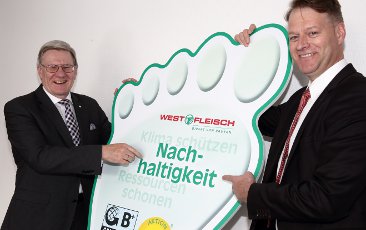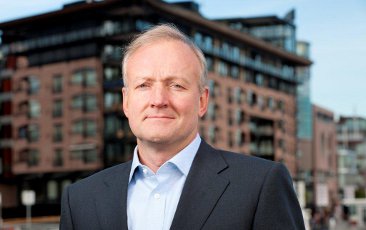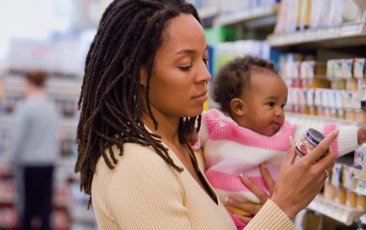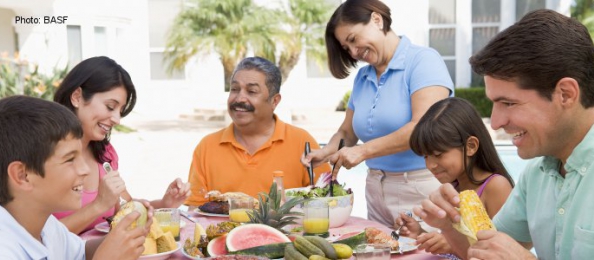Applied Sustainability for the Foodstuffs Industry
Around nine billion people will live on planet earth in the year 2050. This outlook poses enormous global challenges to us. Innovative strategies turn challenges into opportunities, especially in the chemical industry: BASF’s products and solutions will contribute to conserving resources, ensuring healthy food and nutrition, and improving quality of life. Sustainability and innovation will be significant driving forces. Three selected case studies show how BASF collaborates in the field of nutrition and health with its customers to produce consumer goods more sustainably.
Innovative product developments and strategic sustainability tools are tangible measures with which BASF emphasizes its corporate mission: “We create chemistry for a sustainable future.” One example is SET – applied sustainability™, which is a customer-oriented sustainability strategy that helps improving sustainability along the entire value chain.
| Initiator | BASF |
| Project start | - |
| Status | ongoing |
| Region | Worldwide |
| Contact person | Christine Haupt |
| Awards | Meat Vision Award 2013 |
Project benefit
- Sustainable value chains
- Sustainable nutrition
| Anti-Corruption | - |
| Business & Peace | - |
| Development | X |
| Environment | X |
| Financial Markets | - |
| Implementing UNGC Principles in your Corporate CSR Management | - |
| Human Rights | X |
| Labour Standards | - |
| Local Networks | - |
| Advocacy of global issues | X |
| Business opportunities in low income communities/countries | - |
| Project funding | - |
| Provision of goods | - |
| Provision of services/personal | - |
| Standards and guidelines development | - |
BASF’s division Nutrition & Health develops, produces, and markets a comprehensive range of products and services for human and animal nutrition, as well as the pharmaceutical, flavor, and fragrance industries. The division strives to contribute to a better quality of life by improving the nutrition, health, and well-being of people across the world. A balance between economic, ecological, and social needs is a prerequisite to successfully finding the best solutions for a sustainable future. The SET team works together with and for BASF customers and other stakeholders to achieve this balance.
Understanding and activating value chains
Consumers and retailers are increasingly looking for products that contribute to a more sustainable lifestyle. SET – applied sustainability™ helps foodstuffs producers measure the sustainability of their products and identifies specific potential for improvements along the entire value chain: from the use of raw materials through to production and all the way to consumption by the end-consumer and finally disposal.
As “The Chemical Company,” BASF possesses an extraordinarily wide range of expertise in different industries. Thus, customers in the foodstuffs industry benefit from close collaboration among BASF’s agricultural experts, feed and food ingredient specialists, packaging experts, as well as from BASF’s comprehensive view on sustainability challenges along the entire value chain. Well-integrated in its different stages, BASF can activate the value chain for sustainable development.
This widespread network also lets BASF maintain a clear understanding of what moves the market. BASF is a founding member and board member of The Sustainability Consortium (TSC), an independent network that also includes leading and globally active wholesale corporations and consumer goods manufacturers. “We’re active in the TSC in order to understand consumer expectations from the point of view of retailers and of our customers. This lets us anticipate market demands and find innovative solutions,” explains Kristina Gräper, head of SET – applied sustainability™, BASF Nutrition & Health.
SET – applied sustainability™ is distinguished from many sustainability initiatives by its direct relationship to the product. SET – applied sustainability™ applies comprehensive sustainability analyses and strategies to actual customer products, making sustainability tangible and measurable. Whether it is orange juice, headache pills, fragrances, or beef – every product can be continuously made more sustainably, regardless of whether it is produced in a conventional manner or under the provisions of an organic “Bio” standard. SET – applied sustainability™ takes products “on a journey” to higher sustainability. “The proof of improved sustainability creates additional value for the consumer, the producer, and his brand,” explains Gräper.

Photo: BASF
Award-winning sustainability strategy
A specific example of applied sustainability is the CO2 balance calculated together with meat product marketer Westfleisch for the complete pork, beef, and veal production chains. Headquartered in Germany, Westfleisch is one of Europe’s largest marketers of meat products.
The SET team, led at the European level by Dr. Christoph Günther, investigated the amount of greenhouse gas (CO2e) generated along the entire value creation chain. Knowing how much greenhouse gas emissions are generated – and where exactly along the value chain – is the crucial prerequisite for continuously reducing emissions and effectively communicating this success to the market.
Christoph Günther explains: “There are a variety of levers for fine-tuning the improvement of sustainability. With our compre¬hensive approach we find potential for opti¬mization and help our customers exploit this potential.” In 2010 the first CO2 balance for pork clearly showed how strongly the production of animal feed affects the CO2 balance: More than 50 percent of the CO2 footprint for pork production was based on this factor. This included CO2-relevant fertilizers and measures for plant breeding and plant protection upstream in the value creation chain.
Westfleisch took some effective steps, together with its mixed-feed partners: The soya in feed imported from overseas was replaced in part by domestic oil-seed rape, and wheat was replaced by barley, since barley requires less fertilizer. New technologies in the stall also cut down on energy consumption. Also, animal feed conversion was improved. These measures were visibly successful: A review of the values for pork carried out three years later showed a reduction of 3 percent in the annual amount of greenhouse gas emitted to the earth’s atmosphere.
“Thanks to SET, as a leading company in the meat production sector, we were able to calculate a detailed CO2 footprint for our products. This lets us distinguish ourselves from market competition and actively accommodate our trade partners while meeting consumer expectations at the same time,” says Dr. Helfried Giesen, CEO Westfleisch. On May 3, 2013, Westfleisch received the “Meat Vision Award 2013” from the Industry Press of the Deutsche Fachverlag for its long-term and rigorously implemented sustainability strategy.

Photo: BASF
Value chain profits from optimized fish feed
Another example of applied sustainability is the optimization of fish feed for the Norwegian fish feed producer BioMar. Since 2007 the SET team and the BASF Sustainability Strategy unit have been working together with the customer on a long-term sustainability strategy. The goal: Producing salmon feed more environmentally friendly and ensuring a nutritionally ideal diet for the fish.
Here the BASF team investigated the lifecycle of BioMar products and measured their sustainability along the entire value chain. The analyses clearly showed that an increase in the amount of added plant proteins and a more balanced use of fish meals and fish oils would make the feed more sustainable: The feed consumed less in terms of marine resources.
At the same time the diet was matched to the needs of the salmon. With the help of the Eco-Efficiency Analysis that was developed by BASF and has been successfully applied for over 15 years to more than 500 products and processes, BioMar was able to determine fish diets that were optimal for both the salmon and for BioMar. Here BioMar regularly uses the BASF Eco-Efficiency Manager, which is an online tool that accesses the jointly collected data in real time and simulates the environmental and economic effects of alternative feed recipes at any time.
Salmon fed with optimized fish feeds are among the highest-quality types and are a favored choice for salmon-branding purposes. Jan Sverre Røsstad, Vice President, BioMar North Sea, emphasizes the benefits for all involved: “This strategic approach and the innovative tools from BASF are helpful to all players in the value chain: BioMar, fish farmers, processors, retailers, and other stakeholders as well. Making sustainability tangible and applying it at the product level with SET is very beneficial for us and our products.” The comprehensive sustainability strategy of BioMar has been certified under the ProSustain™ standard of the foundation Det Norske Veritas. The foundation has used an independent evaluation system to define standards for continuous improvements in product sustainability.

Photo: Ariel Skelley/Getty Images/BASF
More sustainable beef – A tangible vision?
A juicy, nutritious beef steak has been an integral part of the human diet for thousands of years. At the same time, concern is growing about the social, ecological, and economic impacts of worldwide beef consumption. The US National Cattlemen’s Beef Association (a contractor to the Beef Checkoff) commissioned the SET team with the performance of a comprehensive sustainability analysis. The overall goal of the entire project is to take the beef industry on a journey for continuous improvement for creating more sustainable beef. In the first phase, scientists, consumers, merchants, nongovernmental organizations, producers, and other stakeholders were surveyed as to which sustainability topics are the most relevant, from their points of view, along the entire value chain for beef in North America and where improvements are necessary. For this purpose, the respondents denominated the most urgent environmental, social, and economic topics related to beef production and consumption. This “outside-in-view” is crucial to gain additional market understanding.
In a second step, the SET team investigates exactly how sustainably the US beef industry actually produces beef and how various measures can impact ecological, social, and economic factors. The experts analyze the manufacturing processes of the US beef industry – from feed production to animal husbandry all the way to beef consumption. This quantitative analysis creates a scientific basis for sound decision making when it comes to enhancing the sustainability of manufactured goods and designing an end-to-end strategy that fosters greater sustainability. The baseline data from the analyses will be used to analyze opportunities for improvement and establish a direction for improving the sustainability attributes of the beef industry. When the project as a whole is completed, the beef producers will receive a tool that will help them continuously optimize their operations in ecological and economic terms.
All three examples above show that there are no standard paths on the journey toward more sustainability. Each company and industry sector has highly varied and individually specific opportunities for approaching the topic for itself and its customers. Established evaluation methods and independent certification help to make the topic tangible and to convincingly communicate progress made. All those involved profit greatly by using multistakeholder networks such as the UN Global Compact to exchange information on positive examples as well as on difficulties encountered, making it possible to learn from one another while working toward a more sustainable future.
This project description was originally presented in the Global Compact International Yearbook 2013.
Christine Haupt works as a Communications Manager for BASF.
About BASF
BASF is the
world’s leading chemical
company. With about 111,000
employees, six Verbund sites and
close to 370 production sites
worldwide we serve customers and
partners in almost all countries
of the world.
Products
The BASF portfolio ranges from chemicals, plastics, performance products and crop protection products to oil and gas.
Write a comment about this page
Your comments are provided by your own free will and you take sole responsibility for any direct or indirect liability. In order to maintain the highest discussion quality, all comments will be reviewed by our editors. You hereby provide us with an irrevocable, unlimited, and global license for no consideration to use, reuse, delete or publish comments in accordance with our Community Guidelines.
About Us // Privacy Policy // Copyright Information // Legal Disclaimer // Contact
Copyright © 2012-2018 macondo publishing GmbH. All rights reserved.
The CSR Academy is an independent learning platform of the macondo publishing group.









